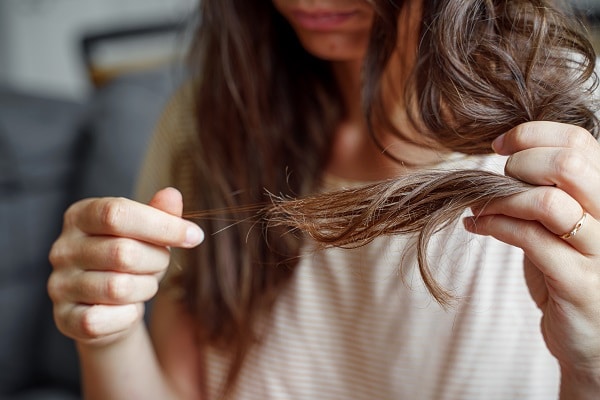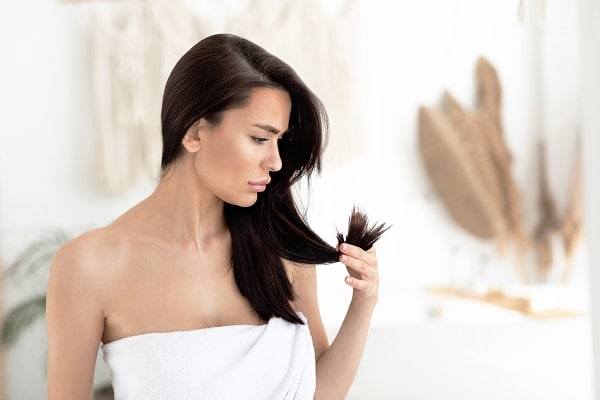Hair health is a reflection of overall well-being. In this fast-paced modern world, various external factors such as environmental pollution, excessive use of heating tools, and chemical treatments can significantly contribute to the state of one’s hair. Understanding the signs of dry and damaged hair is crucial for initiating timely treatment, preventing further damage, and fostering hair’s natural beauty. This blog post elucidates various signals that hair might be sending about its condition. By recognizing these signs, one can take suitable measures to restore hair’s health and vitality.
Hair Thinning

Dry and damaged hair often manifests as thinning strands over time. When hair is undernourished, the strands become weak, resulting in a noticeable reduction in hair volume. This thinning is not to be confused with the natural shedding cycle of hair but is instead a signal of prolonged damage. It’s essential to heed this sign early, as ignoring it may lead to further complications like increased hair fall or even bald patches.
Although thinning can be a common symptom of aging, it could also be the result of dry and damaged hair. This means it is not necessarily inevitable. With proper hair care, including a nutritious diet, good hair hygiene, and minimal use of heating tools, hair health can significantly improve. Regular trims can also prevent the thinning from worsening, as it helps get rid of the damaged ends, giving a chance for healthier hair to grow.
Increased Breakage

Another sign of hair distress is an increased level of breakage. Breakage usually occurs when the hair becomes excessively dry and brittle, causing it to snap easily. It’s important to understand that this is different from the natural hair shedding process. While it’s normal to lose 50 to 100 strands per day, excessive hair on your pillow, clothes, or in your brush could be a sign of abnormal breakage due to dry and damaged hair.
Implementing a routine that nurtures hair can significantly reduce breakage. It can include integrating hair-friendly food into your diet, such as protein-rich food, omega-3 fatty acids, and vitamin E. Moreover, taking a break from heating tools and chemical treatments, and using gentle hair care products can also help maintain hair strength. Additionally, investing time in deep conditioning treatments and hair masks can provide nourishment and strengthen hair, making it more resistant to breakage.
Lack Of Shine And Luster

One of the most noticeable signs of dry and damaged hair is a lack of shine and luster. Healthy hair has a natural shine because it has a smooth cuticle layer that reflects light. When hair is damaged, this layer becomes disrupted, leading to a dull and lifeless appearance. It is important to check for this sign regularly, as it not only affects the look of the hair but can also be indicative of its health.
Reviving the hair’s natural gloss involves rehydrating the hair strands. It’s recommended to use moisturizing shampoos and conditioners and indulge in hydrating hair masks regularly. Avoiding harsh chemical products, which can strip the hair of its natural oils, is also advisable. Emphasizing on staying hydrated by drinking plenty of water can also make a significant difference. Healthy, shiny hair is achievable with consistent care and mindful practices.
Rough Texture

The tactile feel of hair often serves as a great indicator of its health. Dry and damaged hair tends to feel coarse or rough to the touch, largely due to the raised and damaged cuticles. Factors such as exposure to harsh weather conditions, excessive heat styling, and chemical treatments could contribute to this rough texture, making the strands more susceptible to further damage.
Incorporating a routine that targets moisture replenishment can help address the problem of rough texture. Regular use of hydrating hair masks, preferably with natural ingredients like honey, aloe vera, or coconut oil, can work wonders in bringing back the softness. It’s also advisable to protect hair from extreme weather by wearing hats or scarves and reduce the use of heat styling tools. Remember, achieving smoother and healthier hair demands consistent efforts and patience.
Split Ends

Another common and visible sign of dry and damaged hair is the presence of split ends. These occur when the protective outer layer of hair, the cuticle, wears away due to external stressors. This leaves the inner core of hair exposed, causing it to split into two or more parts at the tip. Regularly checking for split ends can help gauge the extent of hair damage and take measures to prevent further harm.
Preventing and repairing split ends starts with regular trims. This helps get rid of the damaged tips and prevents the split from traveling up the hair shaft. Utilizing a hair care routine rich in proteins and essential oils can also significantly contribute to reducing split ends. Limiting the use of heat styling tools and avoiding harsh brushing and towel drying can further protect hair from developing split ends.
Scalp Irritation

The health of one’s hair is intricately tied to the condition of the scalp. Dry and damaged hair can often lead to an irritated scalp, marked by symptoms such as itching, flaking, or redness. This is because a dry, undernourished scalp can struggle to produce enough natural oils needed to keep the hair healthy and moisturized.
Maintaining a clean and healthy scalp should be a top priority in any hair care regimen. Using gentle, sulfate-free shampoos can help clean the scalp without stripping it of its natural oils. Including a scalp massage in your routine can also stimulate blood circulation and promote healthier hair. If scalp irritation persists, it’s advisable to consult with a dermatologist or trichologist to ensure no underlying issues need to be addressed.
Color Fading

The vibrancy of hair color often gets compromised when hair is damaged or dry. Color-treated hair demands an extra layer of care and attention since the chemicals used in dyes and highlights can be damaging. When hair is damaged, the cuticle layer opens up, leading to faster color fading. Regular monitoring of hair color can provide insight into the hair’s health and potential damage.
To maintain color-treated hair, it’s crucial to use products specifically designed for this purpose. Color-protecting shampoos and conditioners, heat protectant sprays, and regular deep conditioning treatments can help preserve the color for a longer duration. Moreover, reducing the frequency of hair color treatments and opting for gentler, ammonia-free hair dyes can also reduce potential damage and prolong color life.
The Bottom Line
Recognizing the signs of dry and damaged hair is the first step in restoring its health. Hair thinning, increased breakage, a lack of shine, rough texture, split ends, scalp irritation, and color fading are all signals that hair might need extra attention and care. Implementing a proper hair care routine and making lifestyle changes can significantly improve hair’s health over time. If symptoms persist, seeking advice from hair professionals is encouraged. Hair is a natural asset that enhances one’s appearance and confidence. Therefore, taking the time to maintain its health and vitality is truly worth the effort.


